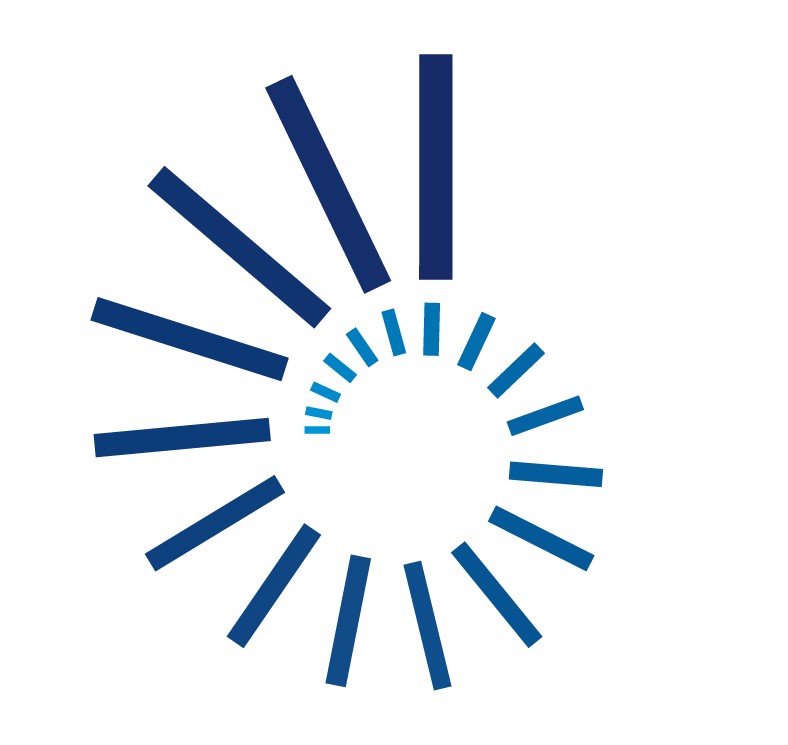Harmonisation
Technology Harmonisation provides all European actors with the framework and the key instruments needed to coordinate space technology at the European level.
This is achieved by identifying the needs and existing capabilities within Europe – as documented in Technology Harmonisation Dossiers – and by agreeing on ‘European Space Technology Roadmaps’, through a process of concertation, coordination and agreement between all participants. These joint Roadmaps aim at optimising public funding and guiding developments to ensure the right technology is at the right level of maturity at the right time.
The process has been developed to achieve better-coordinated research and development activities among actors in the European space sector, establishing a strong technology base as a means of underpinning the worldwide competitiveness of European industry and ensuring the success of future space missions.
Through nearly two decades of operation, and several major reviews that recommended its strengthening, Technology Harmonisation is now an established and well-proven European process. It involves over 1,000 European stakeholders, including ESA, national agencies and organisations, the European Commission, the European Defence Agency, and Space Entities (industry, R&D organisations, academia and associations).
In the scope of Harmonisation, space technologies are currently grouped into 48 topics, covering a wide range of subjects, from electric propulsion and de-orbiting technologies to optical communications and microelectronics. Topics are continuously evolving to recognise the dynamic nature of the space sector and emerging technology trends.
MAIN OBJECTIVES
"Fill strategic gaps" and "Minimise unnecessary duplications"
Consolidate European Strategic Capabilities
Achieve a Coordinated and Committed European Space technology Policy and Planning
Contribute to continuity and coherence between technology and industrial Policies
ESA TECHNOLOGY HARMONISATION ADVISORY GROUP - THAG
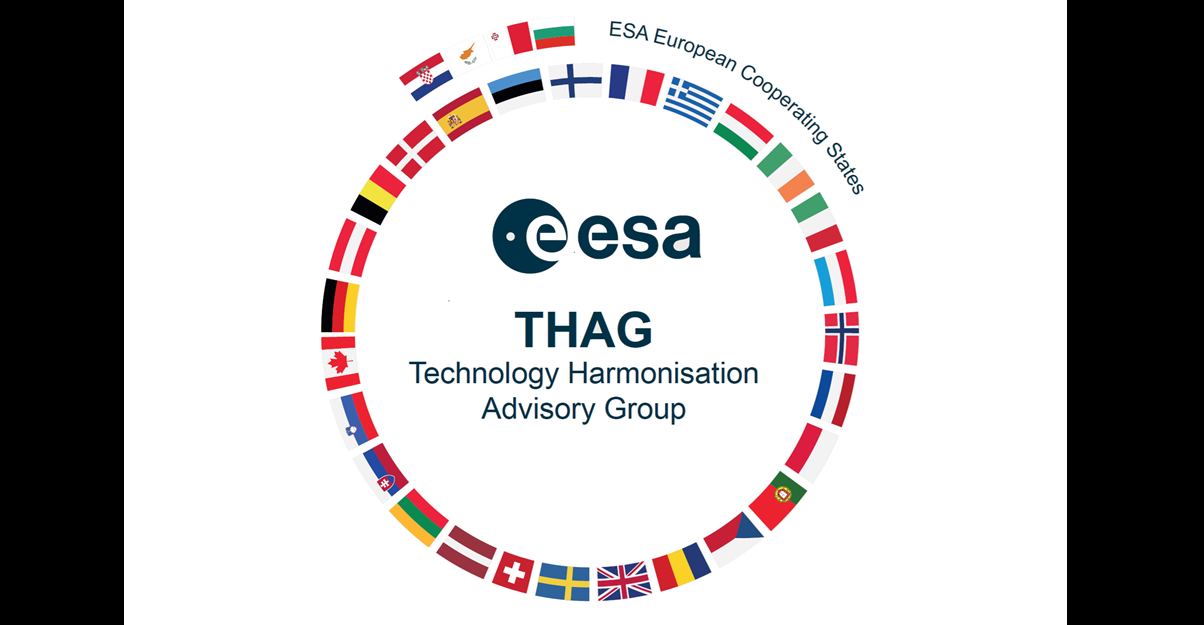
THAG is an ESA delegate body, established in 2006 to advise the ESA Industrial Policy Committee (IPC) on Technology Harmonisation matters, including:
- Technology harmonisation work plans
- Mapping of European capabilities with respect to the needs of the institutional and commercial markets
- Implementation within ESA programmes of agreed roadmaps and conclusions, and identification of national-and European-level funding
- Harmonisation measures to be applied in institutional programmes and by industry
HOW IT WORKS
ESA's Technology Coordination and Planning Office, supervises and coordinates all phases of the Harmonisation process to ensure European space technologies are aligned and strategically developed. Here's how the process works:
- Annual Topics: each year, up to 10 topics are selected for the Harmonisation. These topics are selected based on the last year of revisit, strategic needs and stakeholder input. They are reviewed and updated approximately every 4-5 years.
- Preparation of Dossier: ESA technical experts prepare Technology Harmonisation Dossiers (THDs) for each topic. These documents include strategic objectives, current capabilities and gaps, as well as future technology needs. They are shared with stakeholders via the Harmonisation our Harmonisation Document Management System (HDMS)
- Internal coordination: ESA ensures alignement across technical, strategc and programmatic areas. This guarantees that roadmaps are consistent with ESA's long-term pans and mission requierements.
- External Coordination: the European and Canadian space community participates through open onsultation rounds, held two times per year allowing stakeholders to review and comment on draft technology harmonisation dossiers including strategic roadmaps.
This process ensures coherence in technology developement across Europe, efficint use of resources by avoiding duplication, timely avilability of technologies for future missions.
How to participate
The European Space Technology Harmonisation is a voluntary process, based on transparency and exchange of information. Continuous support from all participants is crucial to the success of this European initiative.
European and Canadian Space Entities are invited to join Harmonisation including:
- Industry
- R&D Organisations and Academia
- Associations
Whether actively participating or not, the results are available to all stakeholders.
Space Entities may submit their inputs on the different technologies addressed during the consultation rounds through one of the channel listed below.
DIRECT PARTICIPATION
on ESA STAR Update your:
- Technology profile
- Entity capability responsible
You will be invited to participate to the consultation and harmonisation meeting when the topic corresponds to your entity capability areas of expertise
PARTICIPATION THROUGH THE NATIONAL DELEGATE
REMAIN IN CONTACT WITH YOUR NATIONAL DELEGATE
The THAG Delegat may recommend how to proceed further.
If you need the contact details of your THAG Delegate, please contact us

Access to Harmonisation Documentation
As a European or Canadian entity, you can request access to the harmonisation database on the Eclipse Polaris platform.
Harmonisation Process phases
Ongoing Harmonisation Cycles - topics and key dates
2026 Topics
Cycle 1 - Consultation Phase
Cycle 2
Actuators Building Blocks for Mechanisms
Ground Station Technology
Pyrotechnic Devices (within release mechanisms)
On-Board Computers, Data Handling Systems and Microelectronics
Printed Circuit Boards and Electronic Assembly Technologies
Avionics Embedded Systems
Additive Manufacturing
On-Board Software
Micro and Nano Technologies – MEMS Pressure Sensors, MOEMS and RF-MEMS
Radiation Environment and Effects
2026 Dates
Cycle 1
Cycle 1
Dec 2025
Feb 2026
Space Entities Consultation Start
17-19 Feb 2026
19-21 May 2026
Harmonisation Meeting
Jul 2026
Nov 2026
Dossiers Pubblication
2025 TOPICS
Cycle 1 - Published
Cycle 2 - Published
On-Board Radio Navigation Receivers
Power Management and Distribution
Critical Active RF Technologies
Power RF Measurements and Modelling
Enabling Artificial Intelligence for Space System Applications
Solar Array Drive Mechanisms
TT&C Transponders and Payload Data Transmitters
Solar Generators and Solar Cells
Functional Verification and Mission Operaions Systems
Harmonisation topics
Frequency and Time Generation and Distribution (Space & Ground)
Last harmonised in 2023.
Ultra-stable frequency and time sources play an important role in many modern applications, such as high-speed data transmission, time keeping, space navigation, and geodesy, and in supporting key elements of basic research in space. The areas covered by this topic include techniques and technologies for the generation, transfer and comparison of ultra-stable time/frequency signals, in both the RF/Microwave domain and in the optical domain (for dedicated payload without optical communications function).
- Time and Frequency generation: Space
- On-board oscillators
- Miniaturised atomic clocks
- Atomic clocks and Clock Monitoring and Control Units
- Microwave photonics
- Time and Frequency generation: Ground
- Microwave clocks
- Optical clocks and related technologies
- Timescale generation
- Time and Frequency transfer and dissemination
- GNSS time and frequency transfer
- Two-Way Satellite Time and Frequency Transfer
- Optical fibre links
- Optical free-space links
For frequency and time distribution over physical or telemetry layer of free-space optical communications links please see Optical Communications for Space.
The Technology Harmonisation Dossier (THD) and Roadmap can be accessed via our Harmonisation Document Management System under the following links: THD LINK / Roadmap LINK
If you do not have an account yet, you may request one by sending an email to harmo@esa.int from a corporate email address providing business affiliation and position in the company.
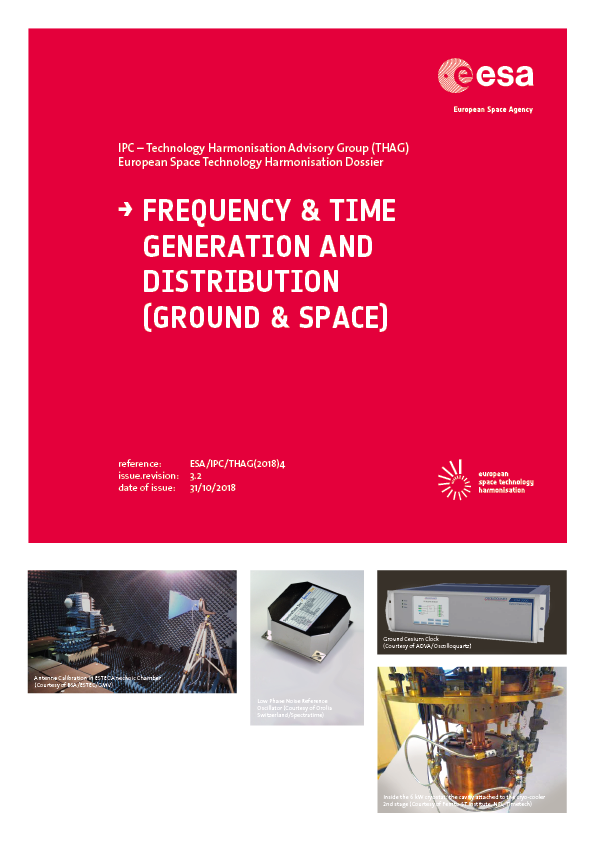
Functional Verification and Missions Operations Systems
Last Harmonised in 2025.
This topic is related to Functional Verification facilities used for development, assembly, integration and test in pre-launch and maintenance phases, and to Mission Operations Systems facilities for remote asset (e.g. satellite, rover, lunar base) monitoring and control during in-flight operations in post-launch phase. In particular, the topic addresses the following facilities and subsystems listed below.
- Functional Verification Bench
- Software Verification Facility
- Spacecraft AIV Simulator
- Ground System Test Simulator
- Training, Operations and Maintenance Simulator
- Electrical Ground Support Equipment systems, including Special Checkout Equipment / Front-end Equipment
- Mission Control Systems
- Data Archiving System
- Data Dissemination System
- Mission Planning Systems
- Ground Stations Monitor and Control System
- Subsystems and components used inside or across these facilities
- Mission Database and Operations Preparation Environment
- Automated Procedure Preparation, Execution and Post-processing Tools
- Data archiving, analysis and distribution, including long term archive of large amount of data
- Simulators
- Process definitions, standards and reference architectures as well as supporting methodologies
The Technology Harmonisation Dossier (THD) and Roadmap can be accessed via our Harmonisation Document Management System under the following links: THD LINK / Roadmap LINK
If you do not have an account yet, you may request one by sending an email to harmo@esa.int from a corporate email address providing business affiliation and position in the company.
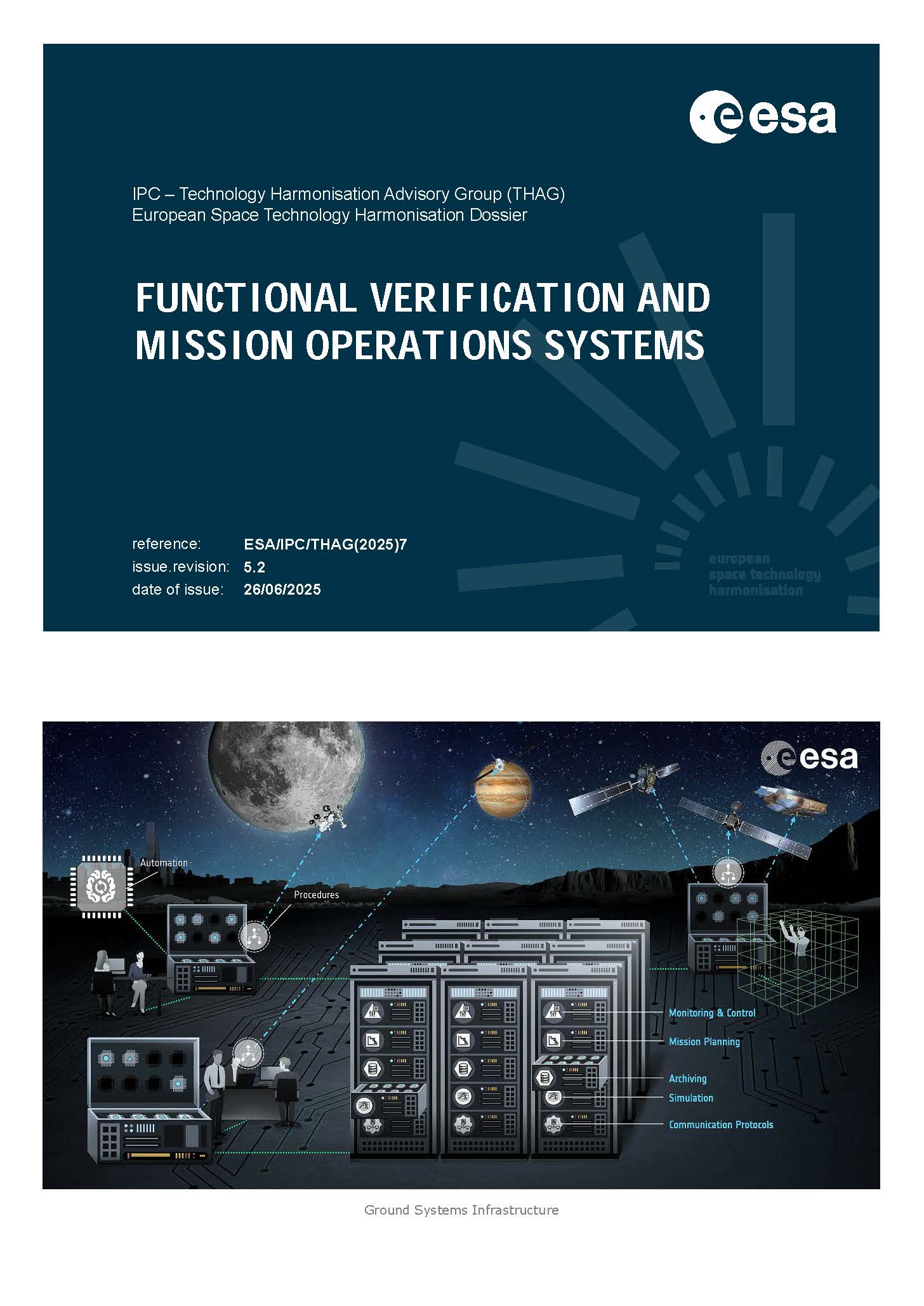
Ground Station Technologies
Last harmonised in 2021.
Ground station technology underpins critical services for the launch, deployment and operation of every space mission: telecommand transmission, telemetry reception from the platform or payload, and tracking and ranging. This topic mainly focuses on Ground Station technologies for the institutional applications, trying to also identify synergies with technologies for commercial services, if applicable.
- Data return via RF: large aperture ground antennas, real time and offline arraying for deep space, multi-frequency feed systems and antenna radome, cryogenically cooled receivers and feed systems, highly stable frequency converters, autonomous receivers with variable/adaptive coding and modulation, CCSDS protocol stack, advanced propagation modelling on link optimization, secure protocols, multiple downlink antenna.
- Data return via optical: optical ground stations for LEO, lunar and deep space direct-to-Earth (including adaptive optics), optical receivers and modems for ground, modulation and coding following CCSDS standard, planning and scheduling.
- Enhanced uplink: ground passive RF elements and feed systems for high power, pointing performance improvements, high-power amplifiers up to 100 kW, equipment for new frequency uplink bands, multiple uplinks in same beam, coding, forward Frame Cross Support Transfer Service (CSTS).
- Digital ground station: direct RF ADC sampling and DAC generation, intermediate frequency over IP, software defined radio, digital signal distribution, secure TTC processing, correlation and arraying of antennas, cloud computing and virtualization).
- Orbit determination accuracy and radio science: radiometric measurements equipment, Ka-band, first signal acquisition for critical operations, multi-frequency uplinks, radiometric calibration.
- Radar space objects observation: transmission and reception including signal synchronisation, calibration, signal processing architecture, correlation algorithms.
- Optical space objects observation: telescope and sensor technologies, active laser ranging technologies.
- Obsolescence and cost reduction: replacement of obsolete technology, monitoring and control for ground stations automation, next generation space link extension and CSTS, real time diagnosis tools.
The Technology Harmonisation Dossier (THD) and Roadmap can be accessed via our Harmonisation Document Management System under the following links: THD LINK / Roadmap LINK
If you do not have an account yet, you may request one by sending an email to harmo@esa.int from a corporate email address providing business affiliation and position in the company.
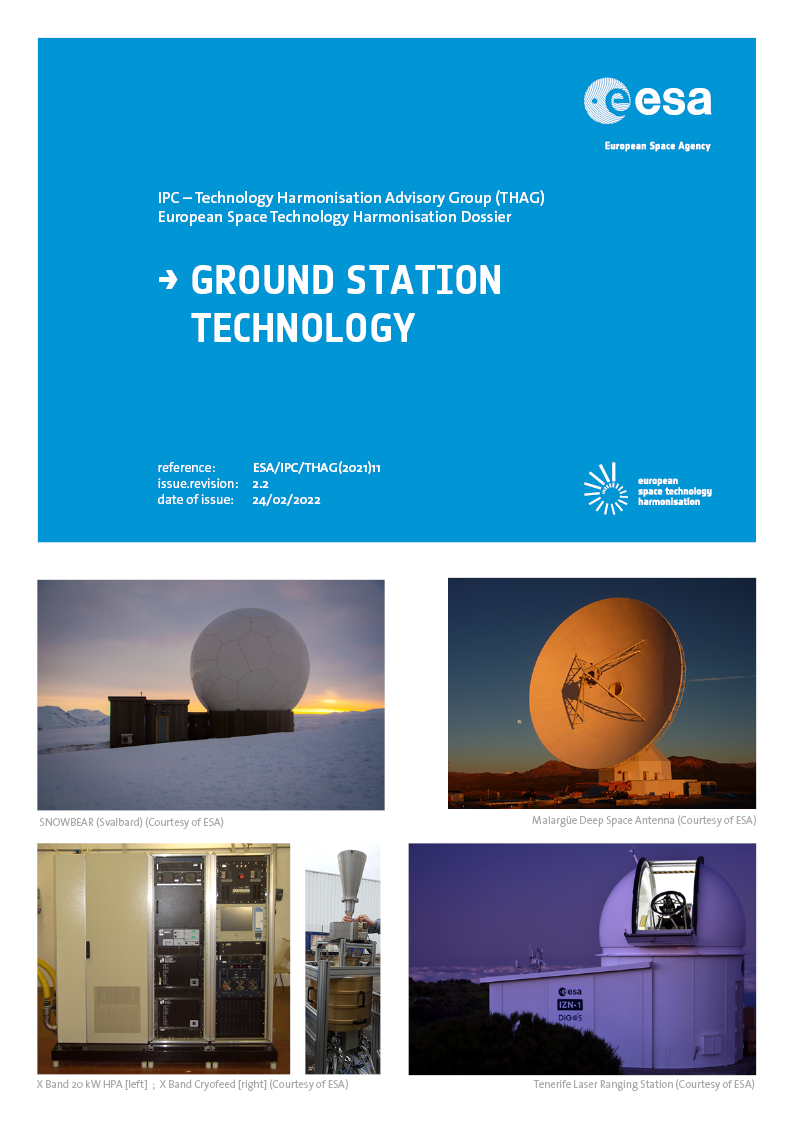
Heat Transport Equipment and Systems
Last harmonised in 2022.
Temperature control of spacecraft requires the use of heat transport equipment and systems. This topic covers both Two-Phase and Single-Phase Heat Transport technologies.
Two-Phase Heat Transport Equipment
- Heat Pipes (HP)
- Constant Conductance Heat Pipes (CCHP), including low-CTE CCHPs and flexible heat pipes
- Variable Conductance Heat Pipes (VCHP)
- Heat Pipe Diodes (HPD)
- Pulsating Heat Pipe
- Two-Phase Structure
- Two-Phase Loop:
- Capillary Driven Loops (CDL): Loop Heat Pipes (LHP), including high, ambient, low and cryogenic temperatures; and Capillary Pumped Loops (CPL)
- Mechanical Pump Loops (MPL)
- Heat Pump Systems including high capacity refrigeration systems
Single Phase Heat Transport Equipment:
- Single Phase Mechanical Pump Loop
- Single Phase Electro-Hydro-Dynamic (EHD) Pump Loop
The Technology Harmonisation Dossier (THD) and Roadmap can be accessed via our Harmonisation Document Management System under the following links: THD LINK / Roadmap LINK
If you do not have an account yet, you may request one by sending an email to harmo@esa.int from a corporate email address providing business affiliation and position in the company.
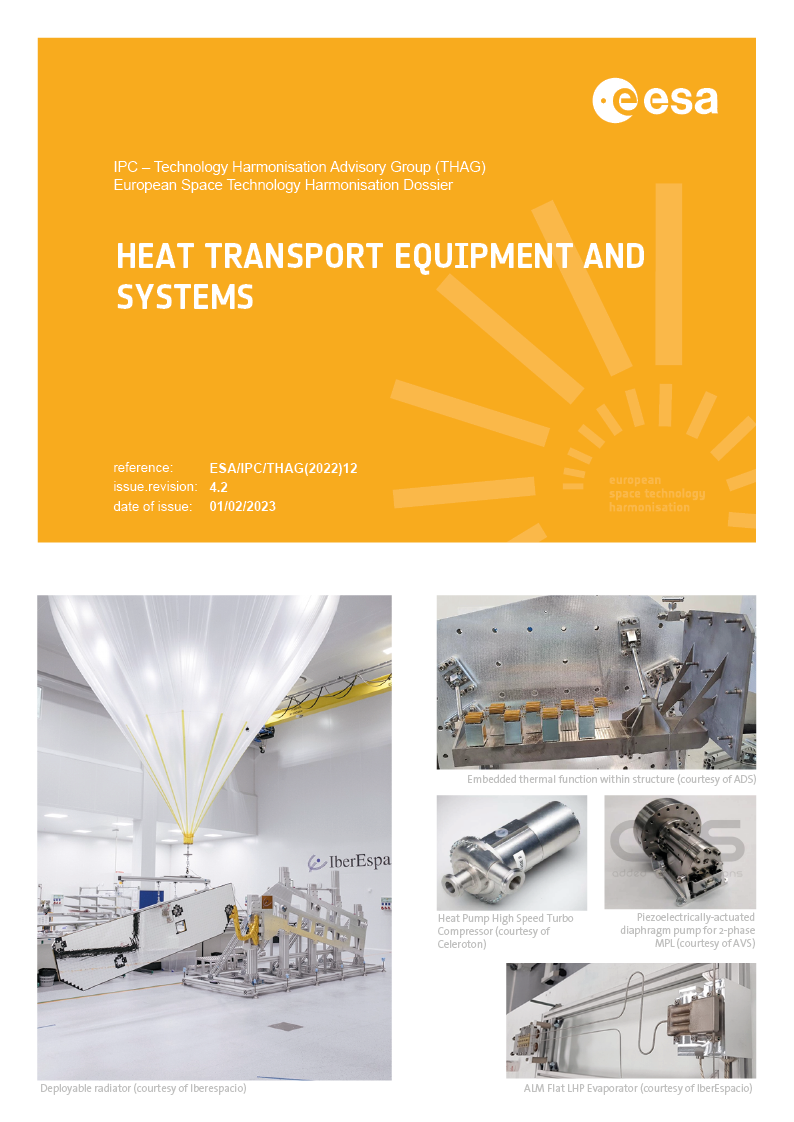
Lidar Critical Subsystems
Last harmonised in 2022.
Lidar instruments have become an important class of optical sensing tools which can be utilised in a vast number of Space and Ground applications, e.g. in scientific, military, environmental and commercial domains. This topic covers three key blocks based on application.
- Atmospheric Lidars: measurement of e.g. greenhouse gas molecules, particle and aerosol, wind doppler. Includes Differential absorption lidar (DIAL), doppler lidars, and frequency comb lidars.
- Altimetry Lidars: surface morphology and geology of planets and small bodies, measurements of vegetation canopy structure, bathymetry. Includes classical detection approach using a high power laser and a receiver detector.
- Imaging Lidars: close proximity guidance and navigation for applications such as rendezvous and docking, automated descents, orbital satellite servicing, navigation and control of robots and rovers, shape sensing or pointing of structures (e.g. deployable antennas). Includes flash lidars and scanning lidars.
The Technology Harmonisation Dossier (THD) and Roadmap can be accessed via our Harmonisation Document Management System under the following links: THD LINK / Roadmap LINK
If you do not have an account yet, you may request one by sending an email to harmo@esa.int from a corporate email address providing business affiliation and position in the company.
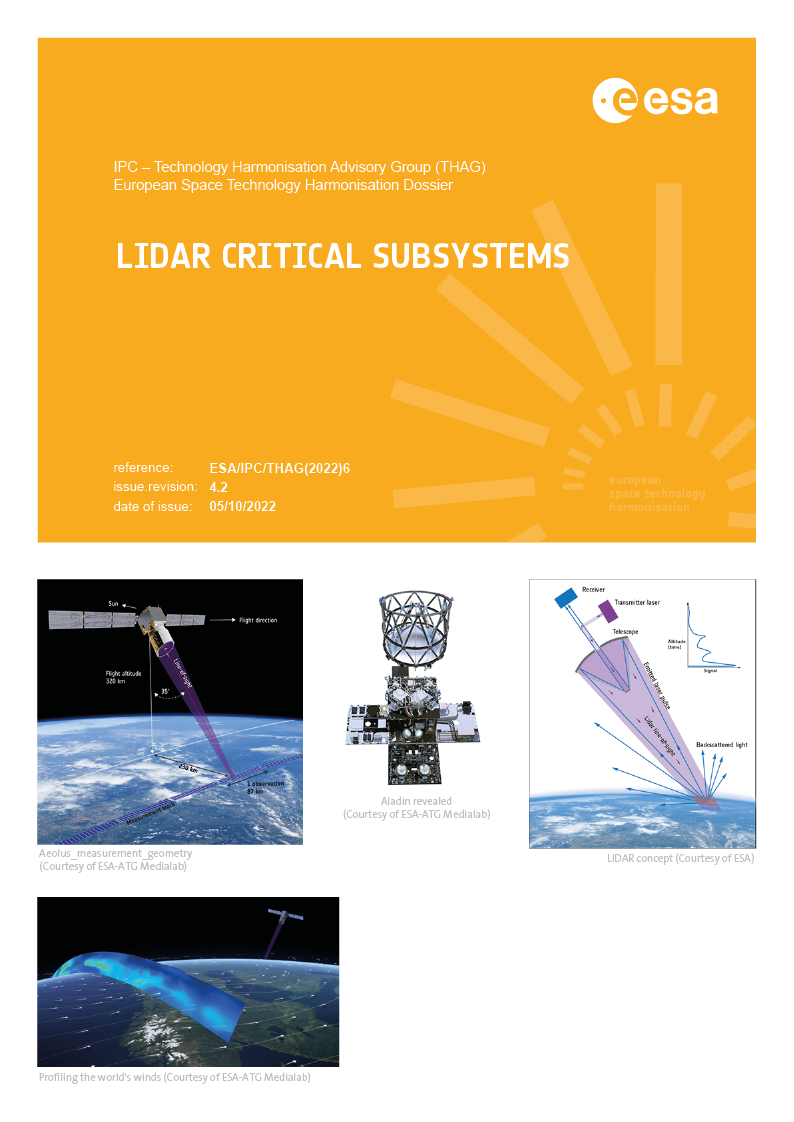
Life Support Technologies (Bioreactors and membrane-based processes)
Last harmonised in 2023.
This topic covers technologies of bioreactors and membrane-based processes, which are needed for the implementation and execution of crewed exploration missions for lunar outposts or Mars transit missions, and planetary exploration (e.g. Moon habitat, crewed Moon rover, Mars habitat).
- Bioreactors
- CO2 processing into oxygen (for atmosphere and food management)
- Solid organic waste processing (for waste management)
- Urine processing (for atmosphere and food management)
- Cultured meat production (for food management)
- Membrane-based processes
- Oxygen or CO2 enrichment (gas-gas separation)
- Product extraction (gas-liquid interface)
- Culture medium recovery (liquid-solid separation)
- Water reclamation (liquid-liquid separation)
- Electrochemical technologies for production of oxygen, enhancement of organic waste degradation, compression of gases for storage, separation/purification of oxygen
- Electrolysis technologies
- Microbial electrolysis cell technology
The Technology Harmonisation Dossier (THD) and Roadmap can be accessed via our Harmonisation Document Management System under the following links: THD LINK / Roadmap LINK
If you do not have an account yet, you may request one by sending an email to harmo@esa.int from a corporate email address providing business affiliation and position in the company.
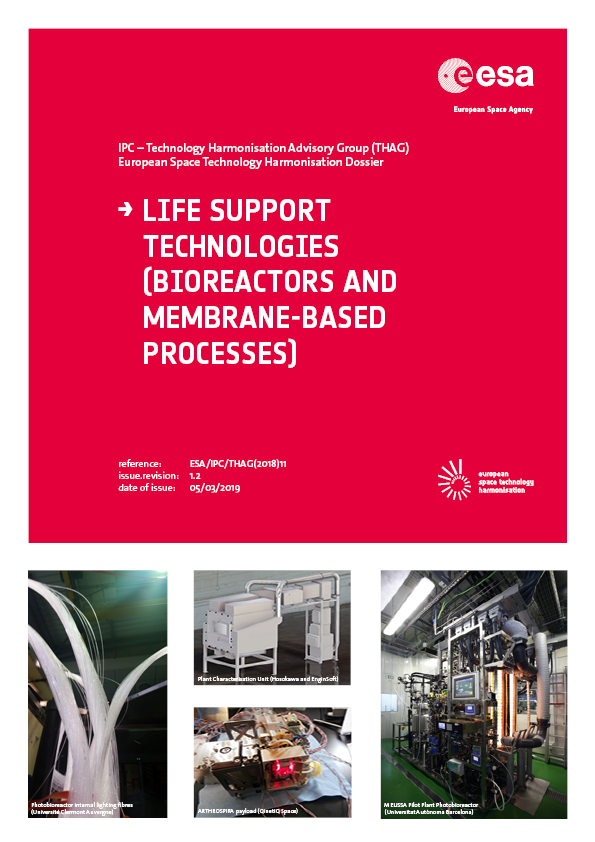
Micro and Nano Technologies - RF MEMS, MOEMS and MEMS pressure sensors
Last harmonised in 2020.
Micro-Electro-Mechanical Systems (MEMS) play a key role in the on-going miniaturisation of electronic modules and systems for space applications. MEMS components englobe a very large field of technologies and applications. Within Harmonisation three MEMS technologies for space applications are considered.
- MEMS Pressure Sensors
- Piezoresistive Pressure Sensors
- Capacitive Pressure Sensors
- Micromachined Pirani Sensors
- MOEMS (Micro-Opto-Electro-Mechanical Systems)
- Optical switches and switching matrices
- Variable optical attenuators
- Tilting micro-mirrors for fine optical beam steering
- Tuneable spectral filters
- RF MEMS
- RF MEMS switches and associated matrices
- Micromachined RF filters (MEMS fabrication processes but no moving part)
- RF MEMS varactor
- Associated RF MEMS Hermetic packaging
- MEMS micro-coolers: devices made with MEMS technology for application in the packaging of high-power component
The Technology Harmonisation Dossier (THD) and Roadmap can be accessed via our Harmonisation Document Management System under the following links: THD LINK / Roadmap LINK
If you do not have an account yet, you may request one by sending an email to harmo@esa.int from a corporate email address providing business affiliation and position in the company.
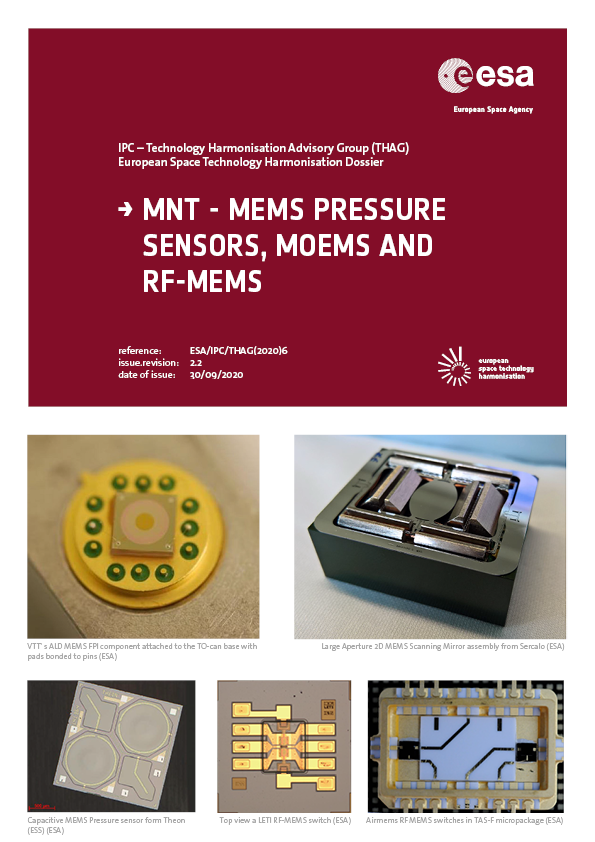
Microwave Passive Hardware
Last harmonised in 2022.
Microwave passive devices are present in all kinds of satellite systems. The repertoire of on-board microwave passive technologies and equipment is very wide and it covers the units or components that do not have any active parts but permit essential payload functionality (filtering, connection, power splitting, routing, etc.). The coverage of this topic is classified as listed below.
- Low and high power filters, diplexers and multiplexers
- Power dividers, combiners, couplers and multiport couplers
- Ferrite devices: isolators, circulators, phase shifters
- RF harness: connectors, cables & cable assemblies, loads, attenuators and waveguides
- RF coaxial and waveguide relays and switches
The Technology Harmonisation Dossier (THD) and Roadmap can be accessed via our Harmonisation Document Management System under the following links: THD LINK / Roadmap LINK
If you do not have an account yet, you may request one by sending an email to harmo@esa.int from a corporate email address providing business affiliation and position in the company.
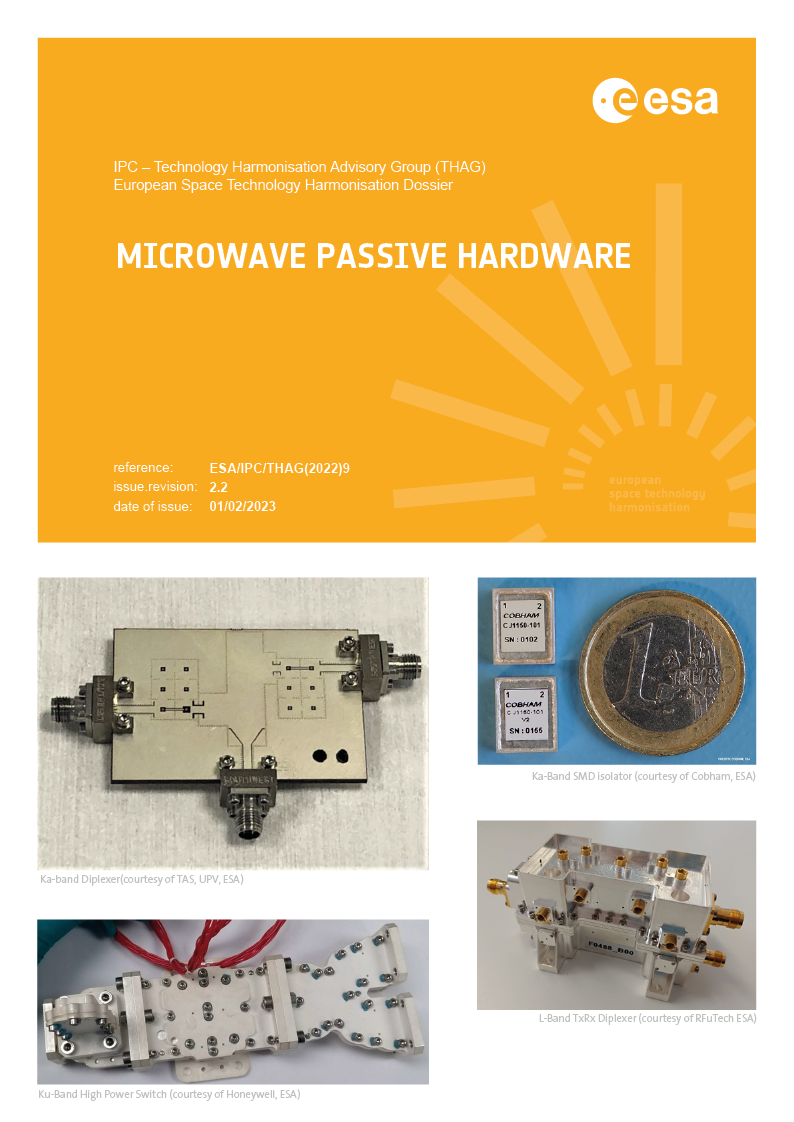
Model Based for System Engineering
Last Harmonised 2024
Model Based for System Engineering topic addresses the use of model-based technologies to support system engineering. It involves the structured application of modelling to support system requirements, design, analysis, verification and validation activities in space systems engineering context, covering the entire life cycle from needs identification to disposal.
Providing timely and direct access to consolidated, well-structured and interlinked data from different actors (specialist disciplines) creates digital continuity, which significantly improves communication between all stakeholders involved and therefore reduces the chances of late discovery of errors and costly rework. Moreover, data exchange based on a well-defined common vocabulary allows to seamlessly integrate powerful design and analysis tools, providing the capability to handle complex system designs more effectively.
For model-based techniques specifically for functional verification and for ground segment, in view of developing simulators, see Functional Verification and Mission Operations Systems.
For the specific modelling and simulation technology see System Modelling and Simulation Tools.
The Technology Harmonisation Dossier (THD) and Roadmap can be accessed via our Harmonisation Document Management System under the following links: THD LINK / Roadmap LINK
If you do not have an account yet, you may request one by sending an email to harmo@esa.int from a corporate email address providing business affiliation and position in the company.
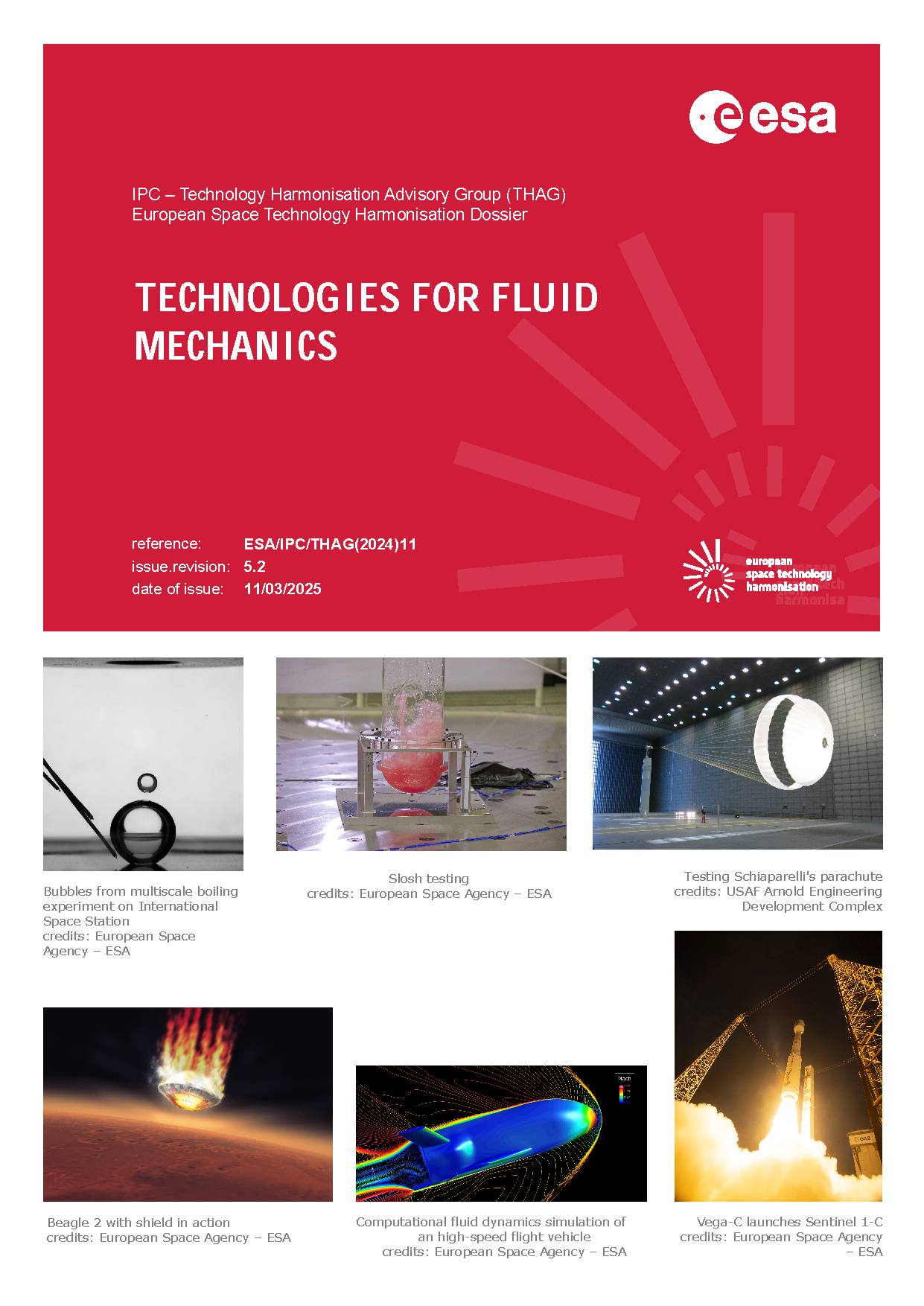
On-board Computers, Data Handling Systems and Microelectronics
Last harmonised in 2021.
Every modern spacecraft is equipped with an On–Board Computer & Data Handling System (OBCDHS), which is responsible for the command and monitoring. The OBCDHS implements spacecraft management and mission management functions as an extension of the Ground Control and Operation Centre. Complex Microelectronic circuits are of capital importance to achieve miniaturisation and performance levels demanded by today’s and future space OBCDHS modules, other platform systems and satellite instruments. This topic covers the areas listed below.
- Computer and Data Handling Systems (CDHS) architecture, units, modules and communication systems
- Platform and Payload CDHS Architectures background
- CDHS units, modules and functions (PF+PL)
- CDHS communication links, buses and networks
- Microelectronic devices and enabling technology
- FPGA
- Microprocessors, microcontrollers, Digital Signal Processing
- Application Specific Standard Products (digital, analogue and mixed-signal)
- ASIC platforms (rad hard cell libraries, IP, Design Kits, packaging, supply chain space quality)
- IP Cores
- CDHS EGSEs & Microelectronics Development methods and tools
- EGSE and tools for CDHS used at satellite level or instrument level
- EGSE for CDHS Units
- EGSE that are used to verify the proper functionality of a module to be then integrated in a CDHS unit.
- Microelectronics development methods and tools
The Technology Harmonisation Dossier (THD) and Roadmap can be accessed via our Harmonisation Document Management System under the following links: THD LINK / Roadmap LINK
If you do not have an account yet, you may request one by sending an email to harmo@esa.int from a corporate email address providing business affiliation and position in the company.
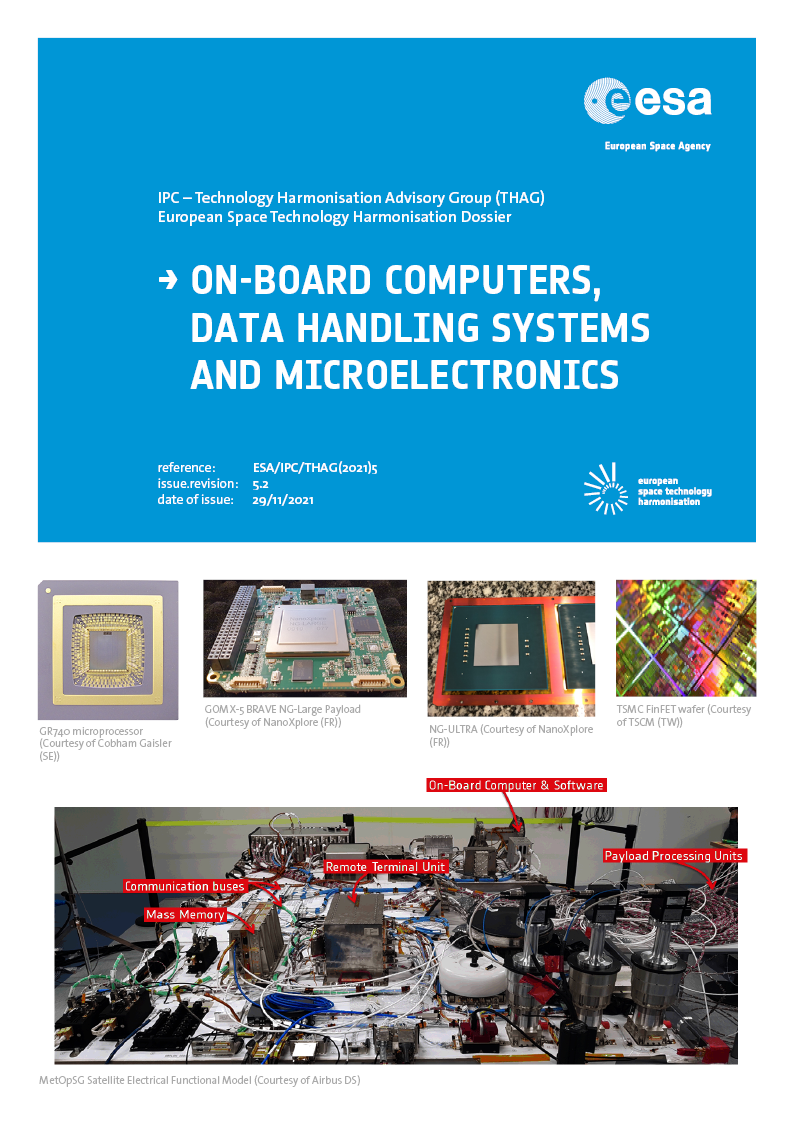
The European Space Technology Master Plan
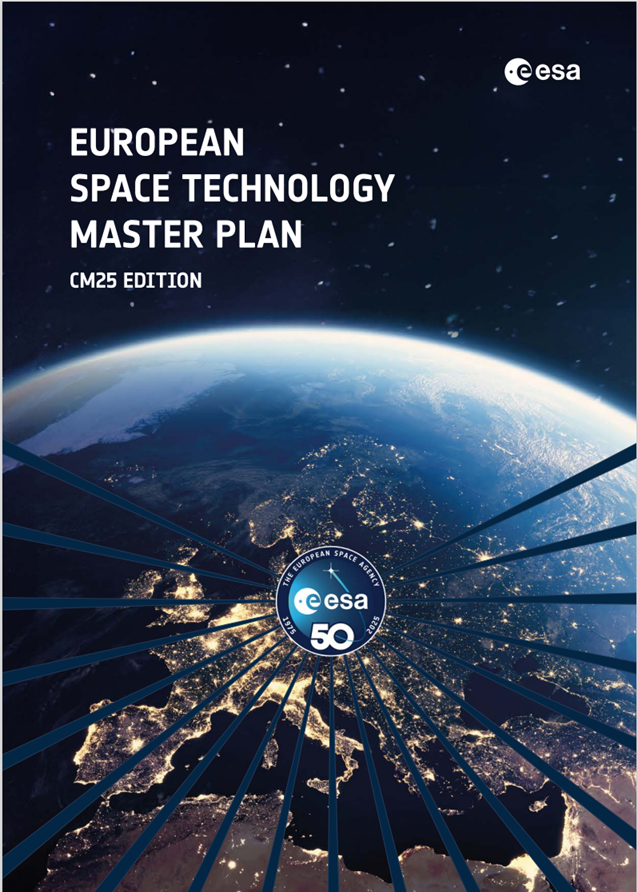
The European Space Technology Master Plan (ESTMP) 2025 provides a comprehensive overview of Europe’s strategic approach to space technology development. Published for the ESA Ministerial Council 2025, this edition CM25 marks both the 50th anniversary of ESA and 25 years of the European Space Technology Harmonisation process.
The CM25 ESTMP Edition gives an overview on:
- Space Technology R&D budgets in Europe in 2024
- The structure and objectives of the new Harmonisation process, involving ESA, national agencies, industry, academia, and associations
- ESA Technology Programme landscape
- The drive for European non-dependence in critical technologies
- ESA Council at Ministerial level – CM25: ESA’s long-term strategy and vision for 2040, outlining goals for innovation, sustainability, and competitiveness
The ESTMP serves as a reference for stakeholders across Europe, supporting informed decision-making and fostering collaboration to ensure Europe remains at the forefront of space technology
To access to the publication please contact us by email at estmp@esa.int from a corporate email address providing business affiliation and position in the company.



